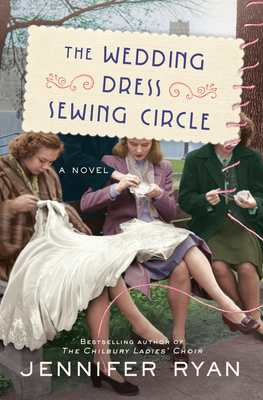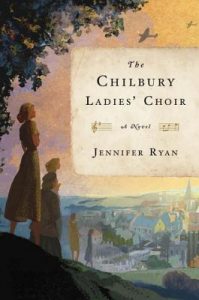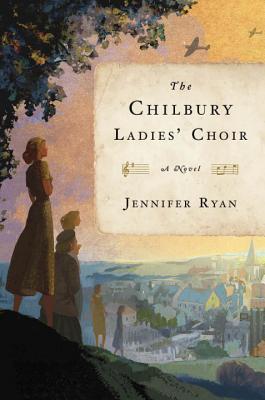 The Wedding Dress Sewing Circle by Jennifer Ryan
The Wedding Dress Sewing Circle by Jennifer Ryan Format: eARC
Source: supplied by publisher via NetGalley
Formats available: hardcover, paperback, large print, ebook, audiobook
Genres: historical fiction, historical romance, World War II
Pages: 411
Published by Ballantine Books on May 31, 2022
Purchasing Info: Author's Website, Publisher's Website, Amazon, Barnes & Noble, Kobo, Bookshop.org, Better World Books
Goodreads
Three plucky women lift the spirits of home-front brides in wartime Britain, where clothes rationing leaves little opportunity for pomp or celebration—even at weddings—in this heartwarming novel based on true events, from the bestselling author of The Chilbury Ladies' Choir.After renowned fashion designer Cressida Westcott loses both her home and her design house in the London Blitz, she has nowhere to go but the family manor house she fled decades ago. Praying that her niece and nephew will be more hospitable than her brother had been, she arrives with nothing but the clothes she stands in, at a loss as to how to rebuild her business while staying in a quaint country village.
Her niece, Violet Westcott, is thrilled that her famous aunt is coming to stay—the village has been interminably dull with all the men off fighting. But just as Cressida arrives, so does Violet's conscription letter. It couldn't have come at a worse time; how will she ever find a suitably aristocratic husband if she has to spend her days wearing a frumpy uniform and doing war work?
Meanwhile, the local vicar's daughter, Grace Carlisle, is trying in vain to repair her mother's gown, her only chance of a white wedding. When Cressida Westcott appears at the local Sewing Circle meeting, Grace asks for her help—but Cressida has much more to teach the ladies than just simple sewing skills.
Before long, Cressida's spirit and ambition galvanizes the village group into action, and they find themselves mending wedding dresses not only for local brides, but for brides across the country. And as the women dedicate themselves to helping others celebrate love, they might even manage to find it for themselves.
My Review:
Eustace Westcott was dead, to begin with. And it seems to be a relief for all concerned, especially his family. His deceased presence turns out to be a bigger blight on the lives of everyone who knew him than the war. Even the local pub still boasts “a certain ditty written in the men’s lavatory” proclaiming that “Eustace Westcott should stick his precious checkbook up a certain part of his anatomy.”
His estranged sister, the famous – or infamous in the late Eustace’s mind – fashion designer Cressida Westcott would certainly agree. She only attended his funeral to make absolutely certain the blighter was dead.
But speaking of that war, when the London Blitz takes out both her house and her design house in the same night, Cressida’s not sure where to go or what to do. She’s lost everything except the clothes on her back, the designs in her head, and a reputation in the fashion industry that she’s spent the last 20 years building. Those will see her through – but first she needs a place to live and regroup.
She never thought she’d go back home to Aldhurst. In fact, she’d sworn she wouldn’t. But Eustace is dead and she can at least hope that his two children, now adults themselves, haven’t turned into carbon copies of their not-so-dear old dad. Or that there’s still time for her to help them become functional human beings now that his oppressive influence over their lives has been removed.
What she finds in the old family pile is a second chance. A chance to get to know the village and its people – and become one of them. A chance to find family again by helping her niece and nephew see that their father’s ideas and influence are holding them back from living their own lives instead of repeating all the restrictions of his.
All the restrictions he tried to impose on Cressida and utterly failed at.
Cressida has a chance to explore a bit of the road not taken and let herself have as much of it all as could ever be possible – not in spite of the war but because of it.
 Escape Rating A: I was looking for, not exactly a comfort read as most of my comfort reads start with murder, but rather a comfortable read for the end of this week. It’s kind of surprising that led me to World War II, not exactly a comfortable time for ANYONE, but this actually fit the bill quite nicely. I adored one of the author’s previous books, The Chilbury Ladies’ Choir, and was expecting more of the same – interesting characters who grow and change in a heartwarming story of the British homefront during World War II. And I was expecting a female-centric story because, well, the war.
Escape Rating A: I was looking for, not exactly a comfort read as most of my comfort reads start with murder, but rather a comfortable read for the end of this week. It’s kind of surprising that led me to World War II, not exactly a comfortable time for ANYONE, but this actually fit the bill quite nicely. I adored one of the author’s previous books, The Chilbury Ladies’ Choir, and was expecting more of the same – interesting characters who grow and change in a heartwarming story of the British homefront during World War II. And I was expecting a female-centric story because, well, the war.
And all of that is exactly what I got. With bells on!
The story revolves around three women, Cressida Westcott, her niece Violet Westcott, and the woman Cressida mentors in Aldhurst, Grace Carlisle. All of their lives have been knocked off their original courses by World War II, but the war also gives each of them a chance to change a course that they thought was set. Hopefully for the better.
Cressida’s change is a driving force in what happens, which is fitting because Cressida herself has always been a driving force in her own life. While her return to Aldhurst allows her to see the place with fresh eyes, her trip back home doesn’t change who she has become in all the years between.
She’s still a driven woman, determined to be in the top echelon of fashion design – and succeeding on her own terms. What her return to Aldhurst allows her to do is to open herself up to new experiences and new friendships. She is still who she has always been, but becoming part of the village – something she was not allowed to do when she was growing up – reminds her that in addition to making a living she also needs to make a life.
Violet and Grace are both in their 20s, and each has planned a certain life for themselves based on what they’ve been taught, what they’ve been told, what they’ve always believed in the “right thing to do.” Violet is honestly a selfish, self-involved little bitch, an upper class twit who believes that marrying a title is her due and that she’s entitled to all the privileges that come with her family’s wealth and status without ever working for them.
Grace is her opposite, the daughter of the local vicar, selflessly devoting herself to the village and parish work, never asking a thing for herself. She’s been shouldering much of her father’s caretaking of the village in the years since her mother died, and everyone else’s need for her has become her life. To the point that she’s planning to marry a clergyman herself, believing that it’s her best chance of recreating the happy family that raised her before her mother’s death.
Violet just needs to grow up – and for that to happen she needs to break out of a role that is designed to keep her childlike and uneducated. Conscription into war work forced Violet to see herself and the world around her with her own eyes, and it’s the making of her.
But it’s Grace’s transformation from colorless drudge to fashion design apprentice that gives the story its heart and its heartbreak. Her involvement with Cressida begins with her engagement, and her desire to wear her mother’s rather moth-eaten wedding gown on her own ‘special’ day.
It’s not just a wish out of love and nostalgia, it’s a necessity. Under wartime clothing rationing, there is no material available for new wedding dresses. There’s little available for repairing old ones, either. But with Cressida’s vast design experience and Grace’s eye for the best ways of ‘making mend and making do’ there’s a chance to make it happen.
Even though the process of design and exploration finally makes Grace wake up and realize that it shouldn’t happen for her – or at least it shouldn’t happen for her with the man she’s currently engaged to marry.
Whether Grace gets to wear the dress herself or not, out of her mother’s old dress both a new dress and a grand idea, The Wedding Dress Sewing Circle of the title, are born. The dress that Violet’s mother gave to Grace’s mother eventually becomes THE dress for many young women of Aldhurst and beyond, in an act of sisterhood that is carried not just around the country, but all the way back home to where it began.
The dress is beautiful on every woman who wears it. And the story of how it came to be is every single bit as lovely.

 The Chilbury Ladies' Choir by
The Chilbury Ladies' Choir by 